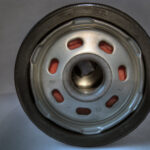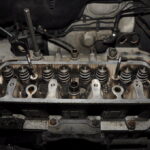Symptoms of Bad Diverter Valve (+How to Fix it)
If your engine seems to be low on boost, or not boosting at all, then you may have a problem with your diverter valve. But do you know what a diverter valve is and what signs indicate that this valve has turned bad?
Don’t worry, in this article, I will explain all about Diverter Valve and how to fix it when it turns bad.
What is Diverter Valve (DV)?
The diverter valve DV is responsible for redirecting exhaust gases away from the turbine inlet when the throttle is closed. Actually, it is an auxiliary component of a turbocharged system.
It is located very near to the turbocharger, and it vents out the excess pressure when the throttle is closed and diverts it back to the air pressure manifold. The excess pressure can be as high as 30 psi. Imagine what would happen if all of the pressure strikes against the throttle plate, and when it has nowhere to go but the compressor housing.
As a result, you hear a sharp honking sound. So, DV is designed and managed to open in these instances to remove excess pressure and avoid any damage to the throttle or turbocharger.
In some vehicles, you would find a turbo cut-off valve, which functions almost similar to the DV. However, the Diverter Valve is mostly found in Volkswagen and Audi Turbocharged engines. People often mix blow-off valve with diverter valves since their function is somewhat similar. The diverter valve diverts the excess air back to the air intake while the blow-off valve sends it out to the atmosphere.
Also read: 10 Best Sports Cars with a Red Interior (+Photos)
What Causes Diverter Valves Problems?
In case, if diverter valve is stuck open, exhaust gases will always be flowing through the turbine, which will reduce boost pressure. If the diverter valve is stuck closed, exhaust gases will be redirected away from the turbine, which will also reduce boost pressure. Either way, you’ll see a drop in the performance.
The diverter valve fails when its diaphragm ruptures. It is electronically controlled, but no failure has occurred due to its electrical flaw; it is always the rubber diaphragm. The rubber diaphragm splits and oils leak out of the connector housing.
What are the Major Symptoms of a Bad Diverter Valve?
No, if the diverter valve, you start witnessing signs like loss of power, honking sounds, and sometimes the DEL might flash.
Loss of Power
The most common symptom of a bad diverter valve is a loss of power. The engine will feel sluggish and may even stall. You may also notice a decrease in boost pressure, as well as increased exhaust noise. If the problem is severe enough, you may even see smoke coming from the tailpipe.
Honking (seagull) type sound
If the diverter valve is stuck open, exhaust gases will always be flowing through the turbine. This can cause a honking (seagull) type sound when you try to accelerate. The sound is caused by the exhaust gases’ turbulence as they flow through the turbine.
CEL may flash
Another symptom of a bad diverter valve is a check engine light (CEL). The check engine light will come on if the diverter valve is not working properly. The light may also come on if there’s a problem with the turbocharger or another engine component. You may witness under boost codes like P0299 and P0244.
However, many users have reported that even when their diverter valve turned bad, the engine light didn’t turn on.
If the diverter valve of your automobile turns bad, the first thing that is greatly affected is its drive and performance. The powerful engine loses some of its power, thus you feel it when driving. The loss in power is due to an incorrect air-fuel ratio being sent to the intake. The car feels sluggish and rough to drive. And as mentioned earlier, you will have to experience honking noises while driving. Apart from that, the engine’s mileage will be affected greatly.
How to Diagnose a Bad DV?
Hissing Noise
If you suspect that your diverter valve is bad, the first thing you should do is check for boost leaks. If there’s a significant boost leak, you will hear a hissing noise coming from the engine bay. You can also check for exhaust leaks by starting the engine and listening for any unusual noises.
Check for Air Leaks
If you don’t hear any boost or exhaust leaks, the next step is to check the diverter valve itself. You can do this by removing the hose that leads from the turbocharger to the diverter valve and feeling for any air leaks. If there are no air leaks, then the problem is most likely with the diverter valve itself.
Inspect the Valve Itself
Next, you need to take out the Diverter Valve and inspect it. For that, follow the guide mentioned in the next section.
Once you have taken out DV, examine its diaphragm, does it look broken? Or does the oil leak out of the connector housing when you took it out? If that’s so, then it has surely turned bad.
Also read: 10 Best 300 HP Cars for Less Than $20k
How to Fix a Bad Diverter Valve?
If you have a bad diverter valve, the best thing to do is replace it with a new one. You can find replacement diverter valves online or at your local auto parts store. Be sure to get the correct size and type of valve for your vehicle. For that, you can go through your old valve, and check its part number.
Replacing a Bad Diverter Valve [5 Simple Steps]
You can replace your Bad Diverter Valve by just following a few mentioned steps.
Step 1: Lift the Car
First, lift the car with a floor jack. Place the jack stands underneath the car for safety.
Step 2: Locate the Faulty DV
Then, locate the faulty diverter valve. Look under the passenger side of the car, near the axle attached to the turbocharger.
Step 3: Disconnect and Remove its Bolts
The diverter valve is connected with a connector and fixed with 3 bolts. You will normally find a single-release clipper. You can release the clip by using your thumb and then move the connection down.
Now, you need to look for 3 bolts. Take them off with the 5mm Allen wrench. One of the bolts is hidden on the border of the bottom. Make sure that you remove it as well.
Step 4: Check out the Parts Number and Buy a New One
Simply pull the valve away from the turbocharger so that you can check it. If you have seen one of the earlier diaphragm valves, you will notice that the rubber substance inside is either orange or teal in color.
On the black outer periphery of the valve, you will find its code and parts number. Visit a local auto parts store and find that exact. Nowadays, you can also order online.
Step 5: Reassemble the new DV
Reassemble the diverter valve back as you removed it. Attach the connect and tighten the bolts carefully. Once the process is completed, remove the jack stands and floor jack.
Also read: Can a Wheel Speed Sensor Cause Limp Mode?
What is the Repair and Replacement Cost for a Bad Diverter Valve?
If you plan to change the diverter valve yourself, you will save the labor cost. However, you will still need to buy the part. Diverter valve costs vary based on different models of the car. The diverter valves for Volkswagen and Audi usually cost around $50 to $70. If you add up the labor cost, you will end up at around $90.
A bad diverter valve can cause a lot of problems for your car. That is why it is important to know the symptoms and how to fix it. I hope this article helped teach you how to do just that. If you have any questions, please feel free to leave a comment below.
Sources:
VW Vortex Forum: Bad Diverter Valve Symptoms
YourMechanic: Symptoms of Failing Diverter Valve
Dizzy Tuning: Blow Off/Bypass/Diverter Valve Discussion
1A Auto: What Are the Symptoms of a Bad Turbo?
HumbleMechanic: How The 2.0T Diverter Valve Fails
Shop Dap: Replacement DIY for your 2.0T TSI Turbo Recirculation (DV) Valve






